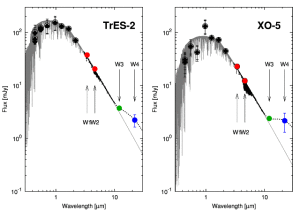Debris disk candidates in systems with transiting planets
Debris disks are known to exist around many planet-host stars, but no debris dust has been found so far in systems with planets discovered by the transit method. In the recently published catalog of the Wide-Field Infrared Survey Explorer (WISE) satellite, we identified 52 stars with transiting planets. Two systems with one transiting "hot Jupiter" each, TrES-2 and XO-5, exhibit small, yet statistically significant, infrared excesses at wavelengths of 12 and 22 micrometers. The excesses are caused by thermal emission of circumstellar dust. That dust must be located at several astronomical units from those stars and is likely to stem from massive "asteroid belts" in these systems. This result extends the list of known "full" planetary systems that harbor both planets and asteroid or Kuiper belt analogs. Furthermore, the presence of "asteroid belts" in systems with transiting planets may put important constraints onto formation and migration scenarios of hot Jupiters.
Spectral energy distributions of the two systems
Grafik: Krivov et al. 2011The figure shows the so-called spectral energy distributions of the two systems, i.e. the emission flux plotted against the wavelength. Grey solid line is the predicted stellar photosphere corrected for interstellar extinction. Diamonds and open circles: visual and near-IR photometry data before and after correction for interstellar extinction, respectively. Filled circles: extinction-corrected WISE data in four bands. The W1 and W2 band circles are still consistent with a purely photospheric emission, while the W3 data (green) and especially the W4 points (blue) are clearly above it, suggesting that dust is present around the respective star. Black dashed line is the modeled emission of the presumed dust rings.
Read the full story in Krivov et al. 2011Externer Link
